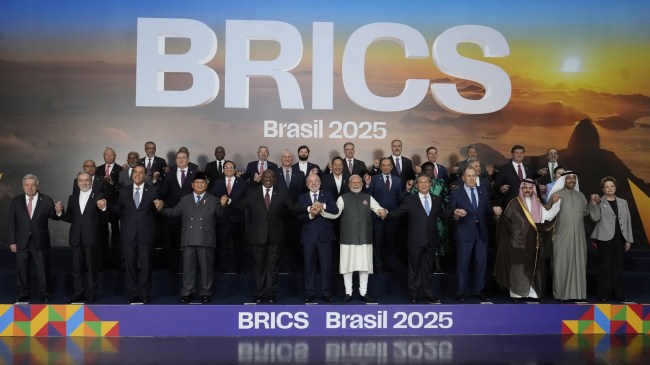Opinion Best of Both Sides: BRICS is China’s playground
As China’s economic might continues to grow, the forum today constrains rather than furthers India’s foreign policy objectives
 Prime Minister Narendra Modi during a group photograph with BRICS members, partners and outreach invitees in Rio de Janeiro, Brazil, on Monday. (PTI)
Prime Minister Narendra Modi during a group photograph with BRICS members, partners and outreach invitees in Rio de Janeiro, Brazil, on Monday. (PTI) As an emerging power, India’s interests are arguably served best by aligning with multiple major powers, which according to conventional wisdom allows Delhi to limit its dependence on any one power and instead work with each on specific issues of common interest. India’s membership of multilateral institutions such as BRICS and the Shanghai Cooperation Organisation (SCO) has been justified along the lines that these provide platforms to push for a more multipolar world order that limits the dominance of Western powers and West-led institutions.
Indeed, BRICS emerged as a group focused on challenging the norms that shaped multilateral economic institutions such as the International Monetary Fund (IMF) and the World Bank. BRICS offered another avenue for India’s aspirations for global leadership as it, along with Brazil, China and Russia, negotiated a larger proportion of quotas and votes at these institutions. In recent years, as BRICS has expanded its membership, it has arguably provided India another platform to develop ties with countries in the Global South. One could argue that as the US under the Donald Trump administration pursues an unpredictable and more volatile foreign policy, it might be even more imperative for India to build ties with such institutions.
But does membership of BRICS really serve India’s interests? What specific foreign policy goals can it pursue through this? The international order is going through a transformation and the contours of the new order are not yet clear, and it is pertinent to ask whether China-dominated institutions such as BRICS will help India or drag it down.
I argue that while BRICS and the SCO still provide India platforms to push for multipolarity, they do not further many of its key foreign policy goals. In some cases, its interests might even be adversely affected through the collective positions taken. Clearly, China’s economic size, assertive foreign policy and dominance in these institutions limit the extent to which India can exert its influence and secure its interests.
China’s GDP, at $17.79 trillion, is nearly five times the size of India’s at $3.56 trillion. This economic might, along with China’s extensive trade and investment ties with other BRICS countries, allow it to exert greater political influence. At the BRICS summits, Beijing has used its leverage to promote goals such as de-dollarisation and expansion of the organisation’s membership. It has also used the venue to advocate for a larger role in global governance for itself. While India seeks to pursue some of these goals, it has not been able to further its interests through BRICS. The redistribution of IMF quotas in 2015 may have been the only exception. Even then, as BRICS countries banded together to reform global governance, China emerged as the clear winner as it was able to secure a deputy managing director position at the IMF.
While India seeks to expand its ties with countries in the Global South and portray itself as their leader, given the deep economic ties China enjoys with other BRICS countries, it is difficult for New Delhi to claim the leadership mantle while operating within the organisation. It might be easier for India to create a leadership narrative through its bilateral ties and in blocs where China is not present.
Additionally, India is deeply conflicted on de-dollarisation. While it has not been opposed to creating alternative payment mechanisms, it has enjoyed strong and increasing trade and investment ties with the US and has sought to limit its dependence on China. Trump’s threat of imposing additional tariffs on BRICS countries pursuing de-dollarisation puts India in a difficult position: Even though New Delhi was never in favour of the policy, it would need to clearly communicate that it is not retreating under threat.
The economic asymmetry within BRICS has also spilled over in the way Beijing has used the New Development Bank, the group’s flagship financial institution. While India has borrowed for its infrastructure projects, it is China that has been able to leverage its economic power to shape the discussion at the NDB around infrastructure and connectivity, which in turn bolsters its Belt and Road Initiative.
It is not only in the realm of economics that New Delhi has seemingly played second fiddle. More recently, to maintain BRICS cohesion, India signed a joint declaration that condemned the terrorist attack in Pahalgam but did not criticise Pakistan for supporting cross-border terrorism. India has fought long and hard to convince the world that Pakistan promotes and exports terrorism — the BRICS declaration went directly against India’s long-held position.
In the early years of the forum, BRICS membership likely gave India a larger profile in global governance by providing a mechanism for policy coordination by emerging economies. As China’s economic might has continued to grow and its foreign policy has increased in ambition and assertiveness, the forum today might constrain rather than further India’s foreign policy objectives. Indian leaders might be well advised to reevaluate BRICS’s utility.
The writer is professor, political science and international affairs, University of Mary Washington




